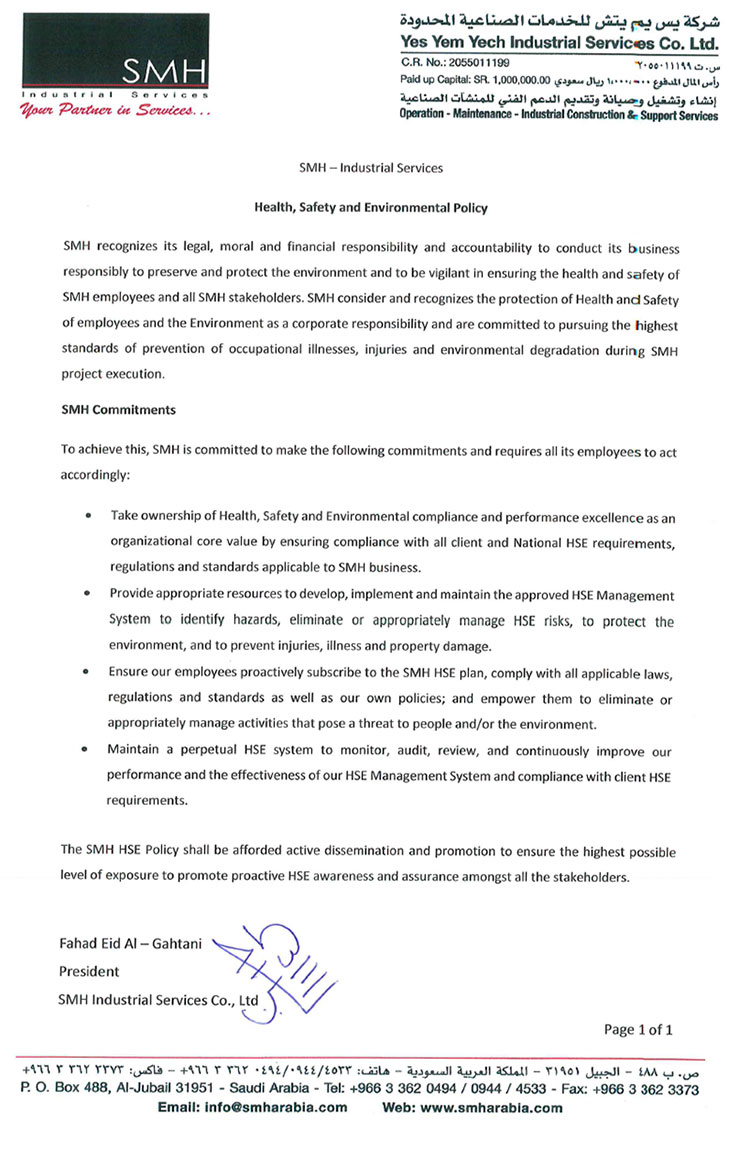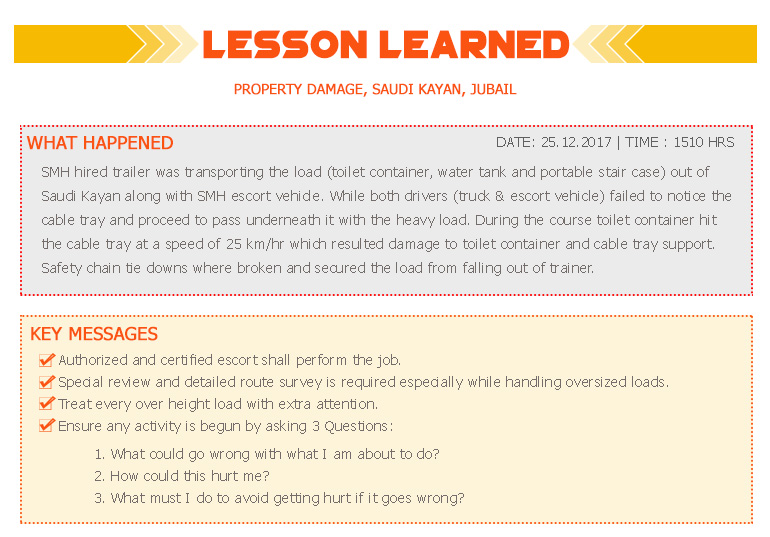Welcome to
SMH Health, Safety and Environment
SMH EHS VISION
"To be the best follower of Safety, Health & Environmental Standards in Petrochemical Industries."Achieving Vibrant Management Systems
Vibrant Management Systems are existing throughout the organization. To make these management systems effective, all employees must clearly understand their roles and responsibilities in managing safety.
Committed Safety Culture
In a Committed Culture, employees involve themselves personally, managers and supervisors drive excellent execution every day, and all employees maintain a sense of vigilance and openness.
Employees strictly follow procedures and speak up when suspect a problem or see an opportunity for improvement.Discipline Adherence to Standards
Follow all SMH Standards to achieve safe warmth completion. These adherence are followed all the time at all our projects, and are continually improved.
SMH identity and manage safety risks arising from gaps through internal audits.Enhanced Applications and Sharing of Learned
To reduce incidents, everyone needs to continually learn. We learn from incidents, near misses, industry benchmarking.
Use a system to efficiently share learning and modify the existing system if required.Competency Development
Through effective trainings and continuous monitoring, we shall improve the individual competency
Fundamental Beliefs
Our fundamental safety beliefs at SMH are...
- Safety is a core business and a personal value
- Safety is a source of our competitive advantage
- We will strengthen our business by making safety excellence an integral part of all activities.
- We believe that all accidents and incidents are preventable
- All levels of management are accountable for our safety performance, starting with the President
Core Elements of SMH Safety Strategy Top Management Commitment
- Safety excellence will be a component of our mission
- Senior management will demonstrate their continual commitment to safety.
- Senior management will hold all employees accountable for safety performance.
Responsibility & Accountability of All Employees
- Safety performance will be an important part of our management/employee evaluation system.
- We will recognize and reward safety performance.
- We will make everyone aware of the safety rules and processes as well as their personal responsibility to observe them.
Clearly Communicated Expectations of Zero Incidents
- We will have a formal written safety goal and we will ensure everyone understands and accepts that goal.
- We will have a communications and motivation system in place to keep our people focused on the safety goal.
Auditing and Measuring for Improvement
- Management will ensure regular safety audits are conducted and that everyone will participate in the process.
- We will focus our audits on the behavior of people as well as the conditions of the operating area.
- We will establish both leading and trailing performance indicators to help us evaluate our level of safety.
Responsibility of All Employees
- Each one of us will be expected to accept responsibility and accountability for our own behavior.
- Each one of us will have an opportunity to participate in developing safety standards and procedures.
- We will openly communicate information about safety incidents and will share the lessons with others.
- Each of us will be concerned for the safety of others in our organization.
SMH EHS POLICY

EHSS POLICY FOCUS
SMH recognizes the protection of Health and Safety of employees and the Environment as a corporate responsibility and is committed to pursuing the highest standards of prevention of occupational illnesses, injuries and environmental degradation during SMH project execution.
The objective is “Zero incident” rate for Safety, Health & Environment. We achieved 10 Million Man-hours without lost time injury. A zero accident rate since our founding.
We achieve our objective through consistent implementation of following measures:
- Job specific safety orientation
- Personal protective equipment (PPE) Awareness
- Periodic safety awareness on important topics.
- Implementation of stringent EHS plans addressing the work risks with elimination / mitigation plans.
- Efficient work place EHS communication with all team members.
- Promote EHS awareness & recognizing EHS performers
EMPLOYEE HEALTH AND WELFARE
Keeping our employees safe and well is our top priority, no matter where they are working. Most of our employees work on Turnaround activities, Maintenance activities and work shop activities away from home – good working and living conditions help to bring about a safer and more productive working environment.
We provide safe and excellent accommodation & welfare facilities for our employees who work away from home. This helps to establish a consistent standard for people who build our facilities around the world.
We also make sure that any employee or contractor working for SMH has access to medical expertise within four hours from where they work – no matter how remote their work location may be. This is possible using advanced telemedicine technology. The technology help doctors better diagnose illness and injuries in the field by bringing specialist medical expertise, through video connection, to some of the remote places where we have operations. It is reducing the need to evacuate people from these locations, while saving lives.
PERSONAL SAFETY
Our people often work in demanding roles and extreme conditions. They may have many different hazards to manage, whether in project locations, construction work in remote locations, or the transport of people, equipment and products. Whatever they do, they always ensure that they can operate safely before they start work.
Everyone who works for us, or with us, has an important part to play in making SMH a safer place to work. We expect people to take personal responsibility in three areas:
- to comply with the safety rules and regulations relevant to their work;
- to intervene to prevent unsafe conditions; and
- to respect fellow workers and the communities in which we work.
Leading the way
Leaders across Shell, at all levels, have a key role to play in understanding the critical safety risks they are accountable to manage, and in ensuring their teams understand their safety responsibilities. Our leadership development programs help leaders to develop a clear safety vision and to continuously reinforce the importance of a safety-first culture at work to employees . Through a culture of care, we ensure our workforce is motivated to perform at its best, delivering quality work in a safe way.
Safety is our top priority every day, and each year we run an annual safety day that gives our employees the opportunity to learn how they can manage the safety hazards in their work and share ideas with each other. We also recognize outstanding performance in safety across SMH with our safety awards and rewards. These attract submissions that recognize the achievements of SMH employees.
SAFETY PYRAMID

Key Performance Indicators (KPI)

Safe Man hours
Safe Man hours - A safe man-hour is a unit of production completed without a lost-time injury or accident.
Fatality
Fatality - is define as the death of human caused by an accident, or is the quality of the disaster being able to cause the death of a human(s). Fatality in the context of occupational health and safety is a death caused by an accident at the workplace, on the way to and from the workplace, or during other works or movements directly or indirectly related to the occupation.
Lost Time Injury
Lost Time Injury - is an injury sustained by an employee that will ultimately lead to the loss of productive work time in the form of worker delays or absenteeism.
Medical Treatment Case
Medical Treatment Case - A recordable incident involving injury or illness that has required management and care of the patient above and beyond first aid, but not severe enough to be a reportable fatality or lost work day case or restricted work day case
Restricted Work Cases
Restricted Work Cases - is when a person is so injured that they cannot perform their normal duties. Therefore they are transferred, temporarily to some other jobs (light duties).
Incident frequency rates
Incident frequency rates data show the yearly frequency rates for recordable injuries, lost-time injuries and disabling injuries for each major industry sector.
Property Damage
Physical damage or destruction of tangible property caused by either an individual or by an equipment who may or may not be the owner of said property or by natural phenomenon.
First Aid
First aid refers to medical attention that is usually administered immediately after the injury occurs and at the location where it occurred. It often consists of a one-time, short-term treatment and requires little technology or training to administer.
